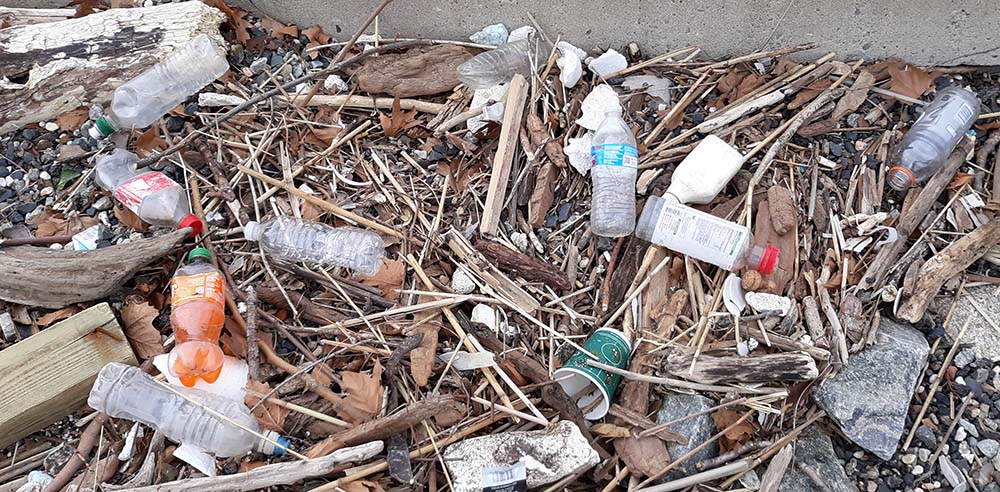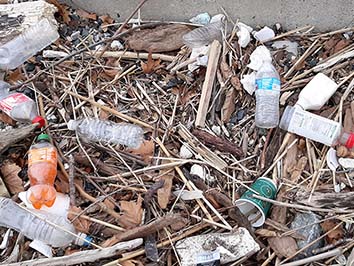
Plastic bottles washed up on shoreline along Hudson River at Sinatra Park in Hoboken, New Jersey.
FBW | January 23, 2019
Reasons to reduce your plastic footprint
Remember that fish you had for dinner the other night? It might have been laced with plastic. Plastics may take hundreds of years to break down. Once in the marine environment, they undergo weathering and degradation into smaller and smaller pieces of plastic, thus creating microplastics.
Scientists have found microplastics in 114 aquatic species and more than half of those end up on our dinner plates, according to a June 2018 article in National Geographic. Each year, a tsunami of plastic — up to 14 million tons — flow into our oceans from coastal areas. The article explains, “Sunlight, wind, waves, and heat break down that material into smaller bits that look — to plankton, bivalves, fish, and even whales — a lot like food.”
Most of these microplastic particles float on the surface of the ocean. Thus, according to a study published in Frontiers in Marine Science in February 2018, 73 percent of seven species of fish caught in the Northwest Atlantic that live deep in the sea but swim to the surface to feed — called mesopelagic fish — were found to have plastic in their stomachs.
The jury is still out on what harm this poses to human health. Scientists are studying this troubling problem. The threat to marine life, however, is clear. Aquatic life that ingest microplastics are known to suffer from inflammation and reduced feeding. Of additional concern, microplastics can bind to chemical pollutants, causing toxins to accumulate in fish.
Particularly insidious are endocrine-disrupting chemicals derived from plastics such as bisphenol A and phthalates. Endocrine disruptors are substances that may mimic or interfere with the function of hormones in the body that can produce cancerous tumors, birth defects and other developmental and neurological disorders in both humans and wildlife.
In 2015, the Proceedings of the National Academy of Sciences released a study entitled “Threat of plastic pollution to seabirds is global, pervasive, and increasing.” This analysis of 186 species of seabirds found 60 percent to have plastic in their gut and 90 percent of all seabirds have eaten some kind of plastic.
So much of the plastic in the ocean comes from everyday use on land. One way cities are trying to limit their plastic pollution is by banning single use plastic bags. City governments banning plastic bags include: Austin, Texas; Boston, Massachusetts; Chicago, Illinois; Los Angeles, California; San Francisco, California and Seattle, Washington. The City of Hoboken added its name to the list by recently passing a ban on single-use plastic bags that went into effect on January 22, 2019.
Need a reusable bag for your shopping? Buy a FBW tote. This stylish bag folds into its corner making it easy to carry with you everywhere. Proceeds help FBW to complete its mission to finish Hoboken’s continuous, public waterfront park.
Related Stories
CARRY ON: Your Hoboken Plastic Bag Ban Survival Guide hMag
The Dangers of Plastic Containers + Local Restaurants That Offer Alternatives HobokenGirl
Related links
Public parks provide essential benefits
Col. Stevens vision for Hoboken still valid 200 years later
Editorial: A Once-in-a-century Opportunity
NJ-APA 2013 Great Places in NJ
Plan for the Hoboken Waterfont
Hoboken’s first parks established in 1804

